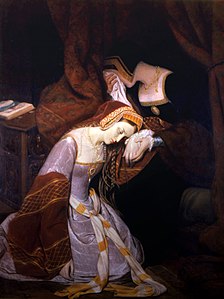Salon of 1835
1835 art exhibition in Paris From Wikipedia, the free encyclopedia
The Salon of 1835 was an art exhibition held at the Louvre in Paris. It was staged during the July Monarchy and was part of the tradition of Salons dating back to the seventeenth century. Since the Salon of 1833 the exhibitions were held annually.

Notable amongst the works on display was Paul Delaroche's history painting The Assassination of the Duke of Guise[1] while Henri Decaisne also submitted a painting featuring a scene from the life of the sixteenth century Duke of Guise.[2] Eugène Delacroix exhibited The Prisoner of Chillon, based on a poem by Lord Byron.[3] Jules Dupré, one of the Barbizon School influenced by John Constable, submitted a landscape painting View of the Pastures of the Limousin.[4]
Antoine-Jean Gros, a leading painter stretching back to the Napoleonic era, displayed the Neoclassical Hercules and Diomedes. Its critical failure led to him committing suicide the same year.[5] Jean-Auguste-Dominique Ingres had exhibited at the Salon for several decade refused a request to submit his Portrait of Louis-Mathieu Molé, a politician soon afterwards to be Prime Minister, having taken over as director of the French Academy in Rome.[6] The previous director Horace Vernet displayed the biblical Rebecca at the Well.[7]
There was a sharp drop in the number of prints and lithographs being exhibited.[8] It was followed by the Salon of 1836.
Gallery
- Portrait of Louise Hersent by Louise Adélaïde Desnos
- The Lute Players by Guillaume Bodinier
- The Discovery of the Laocoon by Pierre-Nolasque Bergeret
- The Arrest of Joan of Arc by Adèle Martin
- Isabeau of Bavaria and the Duke of Burgundy by Jean-Louis Dulong
- John II the Good receives the submission of Charles II the Bad at the Louvre by Merry-Joseph Blondel
- The Invalid's Alms by Aimée Brune-Pagès
- Episode from the Retreat from Russia by Joseph Ferdinand Boissard de Boisdenier
- Greek Woman Preparing to Bathe by Jean-Joseph Espercieux
- View of the Pastures of the Limousin by Jules Dupré
- View of Amalfi in the Gulf of Salerno by Théodore Caruelle d'Aligny
References
Bibliography
Wikiwand - on
Seamless Wikipedia browsing. On steroids.















